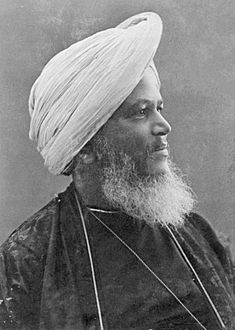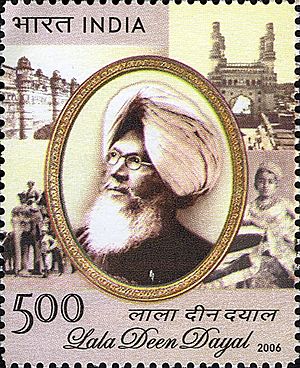Lala Deen Dayal facts for kids
Quick facts for kids
Raja
Lala Deen Dayal
लाला दीन दयाल |
|
|---|---|
 |
|
| Born | 1844 Sardhana, North-Western Provinces, India.
|
| Died | July 1905, aged 61 years |
| Nationality | Indian |
| Alma mater | Thomason College of Civil Engineering, Roorkee |
| Known for | Photography |
Lala Deen Dayal (Hindi: लाला दीन दयाल) was a very famous Indian photographer who lived from 1844 to 1905. He was also known as Raja Deen Dayal. He started his photography career in the mid-1870s, taking pictures for special projects. Over time, he opened his own photo studios in cities like Indore, Mumbai, and Hyderabad.
Lala Deen Dayal became the official photographer for the sixth Nizam of Hyderabad, a powerful ruler named Mahbub Ali Khan. The Nizam gave him the special title of Raja Bahadur Musavvir Jung Bahadur. In 1885, he was also chosen to be the photographer for the Viceroy of India, who was the highest British official in India. In 1897, he received a special honor from Queen Victoria herself.
Early Life and Learning
Deen Dayal was born in a family of jewellers in Sardhana, a town near Meerut in Uttar Pradesh. He went to Thomason College of Civil Engineering in Roorkee (which is now IIT Roorkee). In 1866, he finished his studies there, learning how to be an engineer.
His Photography Career
In 1866, Deen Dayal started working for the government in Indore. He was a head estimator and draughtsman, which means he helped plan and draw designs for building projects. At the same time, he also started taking photos.
His first important supporter in Indore was Tukojirao Holkar II, the Maharaja (ruler) of Indore state. The Maharaja introduced him to Sir Henry Daly, a British official who encouraged Deen Dayal's photography. Soon, Deen Dayal was getting requests to take pictures for other Maharajas and the British government.
In 1868, Deen Dayal opened his own photo studio called – Lala Deen Dayal & Sons. He was then asked to photograph many famous temples and palaces across India. He opened studios in Indore in the mid-1870s, in Secunderabad in 1886, and in Bombay (now Mumbai) in 1896.
In 1875–76, Deen Dayal photographed the royal visit of the Prince and Princess of Wales to India. In the early 1880s, he traveled with Sir Lepel Griffin through an area called Bundelkhand. He took many pictures of the old buildings and architecture there. Griffin asked him to create a collection of archaeological photos. This collection became known as "Famous Monuments of Central India" and included 86 photographs.
Later, Deen Dayal left his government job to focus completely on being a professional photographer. In 1885, he became the official court photographer for the sixth Nizam of Hyderabad. He then moved from Indore to Hyderabad. The Nizam was so impressed that he gave Deen Dayal the honorary title of Raja. Around this time, Dayal started his famous company, Raja Deen Dayal & Sons, in Hyderabad.
Raja Deen Dayal was appointed as the photographer to Queen Victoria in 1897. In 1905–1906, he also photographed the royal tour of the Prince and Princess of Wales.
His Lasting Work
The Indira Gandhi National Centre for the Arts (IGNCA) in New Delhi bought a huge collection of Lala Deen Dayal's work in 1989. This collection has 2,857 glass plate negatives, which are like the original film for old cameras. It is now the largest place where his work is kept. Other large collections of his photos, including famous pictures of the 1870s famine, are at the Peabody Essex Museum in the US and the Alkazi collection in Delhi.
In 2006, some of Raja Deen Dayal's photographs were shown at the Salar Jung Museum during the Times Hyderabad Festival. Later that year, the Indian government released a special postage stamp to honor him.
Gallery
These photographs were taken by Deen Dayal in the 1880s. They are from the British Library and George Curzon's Collection, titled Views of HH the Nizam's Dominions, Hyderabad, Deccan, 1892.
-
Purana Pul, Hyderabad
See also
 In Spanish: Lala Deen Dayal para niños
In Spanish: Lala Deen Dayal para niños








